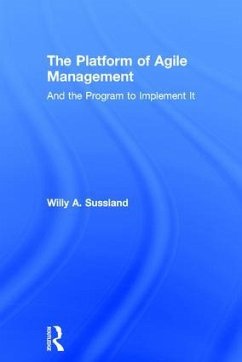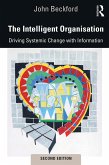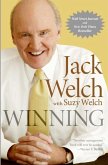- Gebundenes Buch
- Merkliste
- Auf die Merkliste
- Bewerten Bewerten
- Teilen
- Produkt teilen
- Produkterinnerung
- Produkterinnerung
The children of the Internet Revolution - the likes of Google, Facebook, Alibaba, Robo-advisors - are revolutionizing swaths of business sectors. They were born with a fundamentally different mindset, which makes them agile and ambidextrous. To adapt to the new business environment, an increasing number of CEOs are launching programs of management innovation. The agile management platform which Willy Sussland shows nine key principles, paradigms and practices associated with encouraging innovation across your workforce. Leading Agile Organizations provides you with a coherent and cogent…mehr
Andere Kunden interessierten sich auch für
![The Intelligent Organisation The Intelligent Organisation]() John BeckfordThe Intelligent Organisation165,99 €
John BeckfordThe Intelligent Organisation165,99 €![Organizational Change in Practice Organizational Change in Practice]() Annamaria GardenOrganizational Change in Practice86,99 €
Annamaria GardenOrganizational Change in Practice86,99 €![Winning Winning]() Jack WelchWinning8,00 €
Jack WelchWinning8,00 €![Winning Winning]() Jack WelchWinning19,99 €
Jack WelchWinning19,99 €![Managing for Results Managing for Results]() Peter F. DruckerManaging for Results17,99 €
Peter F. DruckerManaging for Results17,99 €![Winning Winning]() Jack WelchWinning15,99 €
Jack WelchWinning15,99 €![Building Businesses from the Inside Out Building Businesses from the Inside Out]() Rebecca BonningtonBuilding Businesses from the Inside Out198,99 €
Rebecca BonningtonBuilding Businesses from the Inside Out198,99 €-
-
-
The children of the Internet Revolution - the likes of Google, Facebook, Alibaba, Robo-advisors - are revolutionizing swaths of business sectors. They were born with a fundamentally different mindset, which makes them agile and ambidextrous. To adapt to the new business environment, an increasing number of CEOs are launching programs of management innovation. The agile management platform which Willy Sussland shows nine key principles, paradigms and practices associated with encouraging innovation across your workforce. Leading Agile Organizations provides you with a coherent and cogent structure for changing the way your organization works to enable, rather than constrain, agility.
Hinweis: Dieser Artikel kann nur an eine deutsche Lieferadresse ausgeliefert werden.
Hinweis: Dieser Artikel kann nur an eine deutsche Lieferadresse ausgeliefert werden.
Produktdetails
- Produktdetails
- Verlag: Taylor & Francis Ltd (Sales)
- Seitenzahl: 210
- Erscheinungstermin: 13. September 2017
- Englisch
- Abmessung: 234mm x 156mm x 14mm
- Gewicht: 494g
- ISBN-13: 9781138289826
- ISBN-10: 1138289825
- Artikelnr.: 57039581
- Herstellerkennzeichnung
- Libri GmbH
- Europaallee 1
- 36244 Bad Hersfeld
- gpsr@libri.de
- Verlag: Taylor & Francis Ltd (Sales)
- Seitenzahl: 210
- Erscheinungstermin: 13. September 2017
- Englisch
- Abmessung: 234mm x 156mm x 14mm
- Gewicht: 494g
- ISBN-13: 9781138289826
- ISBN-10: 1138289825
- Artikelnr.: 57039581
- Herstellerkennzeichnung
- Libri GmbH
- Europaallee 1
- 36244 Bad Hersfeld
- gpsr@libri.de
Dr. Willy A. Sussland is the author or co-author of well over a half a dozen business books as well as of a string of papers that build on his experiences consulting with the senior management of private and public enterprises; in ascending international positions with multinational corporations based in Europe, in the USA, and in Latin America; lecturing strategic management to post-graduate MBAs at the Swiss Federal Institute of Technology Lausanne, and at the University of Geneva.
Introduction Part One: The Principles of The Platform of Agile Management
1. The Why, The Who, and The How Opening remarks 1.1. The why of agile
management 1.2. The who of agile management 1.3. The how of agile
management Closing remarks 2. The 3 Tutors Of Thought and Systemic,
Stimulating, and Systematic Thinking Opening remarks 2.1. The systemic and
strategic principles 2.2. The stimulating and synergizing principles 2.3.
The systematic and swiftness principles 3. The Triple "A" of Agile
Management Opening Remarks 3.1. The basics of agile management Closing
remarks Part Two: The Paradigms of The Platform of Agile Management 4. The
4 Behavioral Drivers 5. The Business Value and The 5 Corporate Capitals
Opening remarks 5.1. The tangible and the intangible resources 5.2. The 5
corporate capitals 5.3. The capital-components Closing remarks 6. The
Organizational Capital and its 5 Capital Components Opening remarks 6.1.
The organizational capital 6.2. The strategy fundamentals 6.3. The systems
of management 6.4. The style of the leadership 6.5. The structures of the
organization 6.6. The shared critical capabilities Closing remarks 7. The
Talent Capital Opening remarks 7.1. The war for talents 7.2. I know talent
when I see it 7.3. The talent capital and the self-manage teams 7.4. The
management of the human resources 7.5. The administration of the human
resources Closing remarks 8. The Market Capital Opening remarks 8.1. The
product capital 8.2. The brand capital 8.3. The customer-capital Closing
remarks 9. The Life- and Time-Cycles, and the Financial Capital Opening
remarks 9.1. The life-cycles and the time-cycles 9.2. The time-cycles 9.3.
The financial capital 10. The 5 Value-Chains Opening remarks 10.1. The
strategic approach to the value-chains 10.2. The structures of the 5
value-chains 10.3. The organizational approach to the 5 value-chains 10.4.
The scrum Closing remarks Part Three: The Practices of The Platform of
Agile Management 11. The Strategic Planning Opening remarks 11.1. The
traditional strategic planning 11.2. The why of strategic planning 11.3.
The who of strategic planning 11.4. The how of strategic planning Closing
remarks 12. The Agile Development and Deployment of Strategies Opening
remarks 12.1. Hoshin Planning 12.2. The Model of the Two Rings 12.3. The 4
steering processes on the outer ring Closing remarks 13. The Model of the
Two Rings and the Agile Modus Operandi Opening remarks 13.1. The agile
modus operandi 13.2. The IT-platform Closing remarks 14. The
Reviews-Evaluations-Recognition System Opening remarks 14.1. The reviews
14.2. The performance evaluation system 14.3. The business-value and the
return on total resources 14.4. The management scoreboard 14.5. The
recognitions and the rewards 14.6. The strategic agility and the
operational agility Closing remarks Part Four: The Program of Management
Innovation 15. Programs of Management Innovation 16. The Decision-Making
16.1. The why 16.2. The who 16.3. The how 17. The Preparations and Building
Support 17.1. The preparation of the launch 17.2. The program of the
introductory seminars 18. The Launch of the Program and the Improvements
19. The Reviews, The Extension, and the Renewal of the Program Part Five:
Leading Thoughts 20. The 5 Avenues for Management Innovation 20.1.
Measuring and managing the business value 20.2. Culture 20.3. The
stakeholders 20.4. The innovation of management innovation 20.5. The tutors
of thought Appendix 1: Maps
1. The Why, The Who, and The How Opening remarks 1.1. The why of agile
management 1.2. The who of agile management 1.3. The how of agile
management Closing remarks 2. The 3 Tutors Of Thought and Systemic,
Stimulating, and Systematic Thinking Opening remarks 2.1. The systemic and
strategic principles 2.2. The stimulating and synergizing principles 2.3.
The systematic and swiftness principles 3. The Triple "A" of Agile
Management Opening Remarks 3.1. The basics of agile management Closing
remarks Part Two: The Paradigms of The Platform of Agile Management 4. The
4 Behavioral Drivers 5. The Business Value and The 5 Corporate Capitals
Opening remarks 5.1. The tangible and the intangible resources 5.2. The 5
corporate capitals 5.3. The capital-components Closing remarks 6. The
Organizational Capital and its 5 Capital Components Opening remarks 6.1.
The organizational capital 6.2. The strategy fundamentals 6.3. The systems
of management 6.4. The style of the leadership 6.5. The structures of the
organization 6.6. The shared critical capabilities Closing remarks 7. The
Talent Capital Opening remarks 7.1. The war for talents 7.2. I know talent
when I see it 7.3. The talent capital and the self-manage teams 7.4. The
management of the human resources 7.5. The administration of the human
resources Closing remarks 8. The Market Capital Opening remarks 8.1. The
product capital 8.2. The brand capital 8.3. The customer-capital Closing
remarks 9. The Life- and Time-Cycles, and the Financial Capital Opening
remarks 9.1. The life-cycles and the time-cycles 9.2. The time-cycles 9.3.
The financial capital 10. The 5 Value-Chains Opening remarks 10.1. The
strategic approach to the value-chains 10.2. The structures of the 5
value-chains 10.3. The organizational approach to the 5 value-chains 10.4.
The scrum Closing remarks Part Three: The Practices of The Platform of
Agile Management 11. The Strategic Planning Opening remarks 11.1. The
traditional strategic planning 11.2. The why of strategic planning 11.3.
The who of strategic planning 11.4. The how of strategic planning Closing
remarks 12. The Agile Development and Deployment of Strategies Opening
remarks 12.1. Hoshin Planning 12.2. The Model of the Two Rings 12.3. The 4
steering processes on the outer ring Closing remarks 13. The Model of the
Two Rings and the Agile Modus Operandi Opening remarks 13.1. The agile
modus operandi 13.2. The IT-platform Closing remarks 14. The
Reviews-Evaluations-Recognition System Opening remarks 14.1. The reviews
14.2. The performance evaluation system 14.3. The business-value and the
return on total resources 14.4. The management scoreboard 14.5. The
recognitions and the rewards 14.6. The strategic agility and the
operational agility Closing remarks Part Four: The Program of Management
Innovation 15. Programs of Management Innovation 16. The Decision-Making
16.1. The why 16.2. The who 16.3. The how 17. The Preparations and Building
Support 17.1. The preparation of the launch 17.2. The program of the
introductory seminars 18. The Launch of the Program and the Improvements
19. The Reviews, The Extension, and the Renewal of the Program Part Five:
Leading Thoughts 20. The 5 Avenues for Management Innovation 20.1.
Measuring and managing the business value 20.2. Culture 20.3. The
stakeholders 20.4. The innovation of management innovation 20.5. The tutors
of thought Appendix 1: Maps
Introduction Part One: The Principles of The Platform of Agile Management
1. The Why, The Who, and The How Opening remarks 1.1. The why of agile
management 1.2. The who of agile management 1.3. The how of agile
management Closing remarks 2. The 3 Tutors Of Thought and Systemic,
Stimulating, and Systematic Thinking Opening remarks 2.1. The systemic and
strategic principles 2.2. The stimulating and synergizing principles 2.3.
The systematic and swiftness principles 3. The Triple "A" of Agile
Management Opening Remarks 3.1. The basics of agile management Closing
remarks Part Two: The Paradigms of The Platform of Agile Management 4. The
4 Behavioral Drivers 5. The Business Value and The 5 Corporate Capitals
Opening remarks 5.1. The tangible and the intangible resources 5.2. The 5
corporate capitals 5.3. The capital-components Closing remarks 6. The
Organizational Capital and its 5 Capital Components Opening remarks 6.1.
The organizational capital 6.2. The strategy fundamentals 6.3. The systems
of management 6.4. The style of the leadership 6.5. The structures of the
organization 6.6. The shared critical capabilities Closing remarks 7. The
Talent Capital Opening remarks 7.1. The war for talents 7.2. I know talent
when I see it 7.3. The talent capital and the self-manage teams 7.4. The
management of the human resources 7.5. The administration of the human
resources Closing remarks 8. The Market Capital Opening remarks 8.1. The
product capital 8.2. The brand capital 8.3. The customer-capital Closing
remarks 9. The Life- and Time-Cycles, and the Financial Capital Opening
remarks 9.1. The life-cycles and the time-cycles 9.2. The time-cycles 9.3.
The financial capital 10. The 5 Value-Chains Opening remarks 10.1. The
strategic approach to the value-chains 10.2. The structures of the 5
value-chains 10.3. The organizational approach to the 5 value-chains 10.4.
The scrum Closing remarks Part Three: The Practices of The Platform of
Agile Management 11. The Strategic Planning Opening remarks 11.1. The
traditional strategic planning 11.2. The why of strategic planning 11.3.
The who of strategic planning 11.4. The how of strategic planning Closing
remarks 12. The Agile Development and Deployment of Strategies Opening
remarks 12.1. Hoshin Planning 12.2. The Model of the Two Rings 12.3. The 4
steering processes on the outer ring Closing remarks 13. The Model of the
Two Rings and the Agile Modus Operandi Opening remarks 13.1. The agile
modus operandi 13.2. The IT-platform Closing remarks 14. The
Reviews-Evaluations-Recognition System Opening remarks 14.1. The reviews
14.2. The performance evaluation system 14.3. The business-value and the
return on total resources 14.4. The management scoreboard 14.5. The
recognitions and the rewards 14.6. The strategic agility and the
operational agility Closing remarks Part Four: The Program of Management
Innovation 15. Programs of Management Innovation 16. The Decision-Making
16.1. The why 16.2. The who 16.3. The how 17. The Preparations and Building
Support 17.1. The preparation of the launch 17.2. The program of the
introductory seminars 18. The Launch of the Program and the Improvements
19. The Reviews, The Extension, and the Renewal of the Program Part Five:
Leading Thoughts 20. The 5 Avenues for Management Innovation 20.1.
Measuring and managing the business value 20.2. Culture 20.3. The
stakeholders 20.4. The innovation of management innovation 20.5. The tutors
of thought Appendix 1: Maps
1. The Why, The Who, and The How Opening remarks 1.1. The why of agile
management 1.2. The who of agile management 1.3. The how of agile
management Closing remarks 2. The 3 Tutors Of Thought and Systemic,
Stimulating, and Systematic Thinking Opening remarks 2.1. The systemic and
strategic principles 2.2. The stimulating and synergizing principles 2.3.
The systematic and swiftness principles 3. The Triple "A" of Agile
Management Opening Remarks 3.1. The basics of agile management Closing
remarks Part Two: The Paradigms of The Platform of Agile Management 4. The
4 Behavioral Drivers 5. The Business Value and The 5 Corporate Capitals
Opening remarks 5.1. The tangible and the intangible resources 5.2. The 5
corporate capitals 5.3. The capital-components Closing remarks 6. The
Organizational Capital and its 5 Capital Components Opening remarks 6.1.
The organizational capital 6.2. The strategy fundamentals 6.3. The systems
of management 6.4. The style of the leadership 6.5. The structures of the
organization 6.6. The shared critical capabilities Closing remarks 7. The
Talent Capital Opening remarks 7.1. The war for talents 7.2. I know talent
when I see it 7.3. The talent capital and the self-manage teams 7.4. The
management of the human resources 7.5. The administration of the human
resources Closing remarks 8. The Market Capital Opening remarks 8.1. The
product capital 8.2. The brand capital 8.3. The customer-capital Closing
remarks 9. The Life- and Time-Cycles, and the Financial Capital Opening
remarks 9.1. The life-cycles and the time-cycles 9.2. The time-cycles 9.3.
The financial capital 10. The 5 Value-Chains Opening remarks 10.1. The
strategic approach to the value-chains 10.2. The structures of the 5
value-chains 10.3. The organizational approach to the 5 value-chains 10.4.
The scrum Closing remarks Part Three: The Practices of The Platform of
Agile Management 11. The Strategic Planning Opening remarks 11.1. The
traditional strategic planning 11.2. The why of strategic planning 11.3.
The who of strategic planning 11.4. The how of strategic planning Closing
remarks 12. The Agile Development and Deployment of Strategies Opening
remarks 12.1. Hoshin Planning 12.2. The Model of the Two Rings 12.3. The 4
steering processes on the outer ring Closing remarks 13. The Model of the
Two Rings and the Agile Modus Operandi Opening remarks 13.1. The agile
modus operandi 13.2. The IT-platform Closing remarks 14. The
Reviews-Evaluations-Recognition System Opening remarks 14.1. The reviews
14.2. The performance evaluation system 14.3. The business-value and the
return on total resources 14.4. The management scoreboard 14.5. The
recognitions and the rewards 14.6. The strategic agility and the
operational agility Closing remarks Part Four: The Program of Management
Innovation 15. Programs of Management Innovation 16. The Decision-Making
16.1. The why 16.2. The who 16.3. The how 17. The Preparations and Building
Support 17.1. The preparation of the launch 17.2. The program of the
introductory seminars 18. The Launch of the Program and the Improvements
19. The Reviews, The Extension, and the Renewal of the Program Part Five:
Leading Thoughts 20. The 5 Avenues for Management Innovation 20.1.
Measuring and managing the business value 20.2. Culture 20.3. The
stakeholders 20.4. The innovation of management innovation 20.5. The tutors
of thought Appendix 1: Maps








